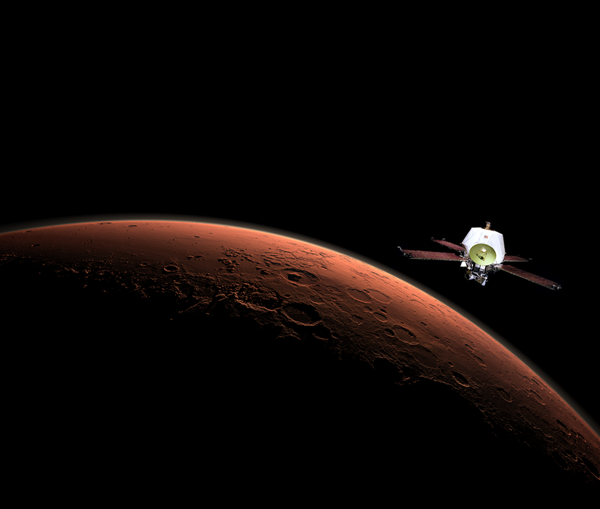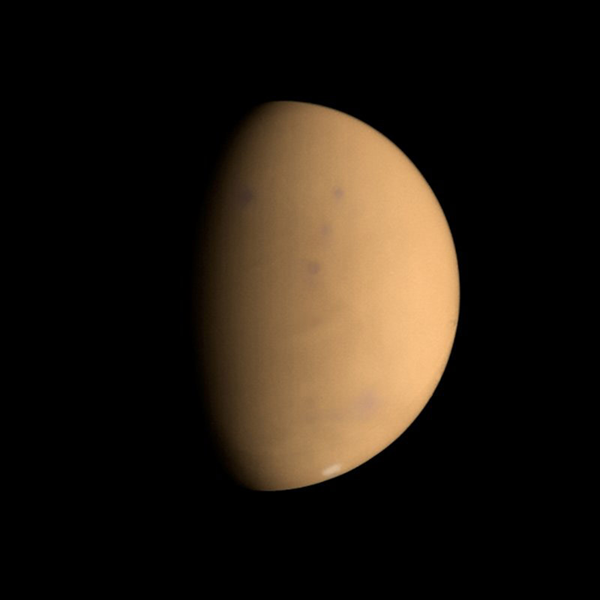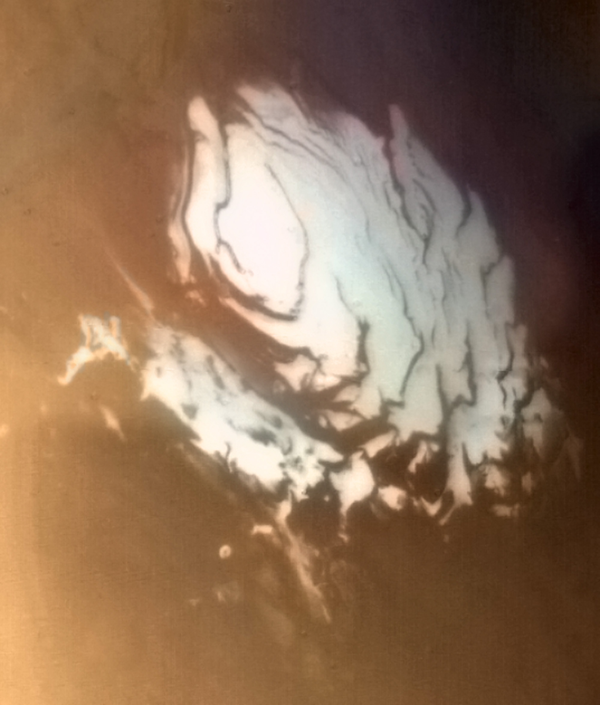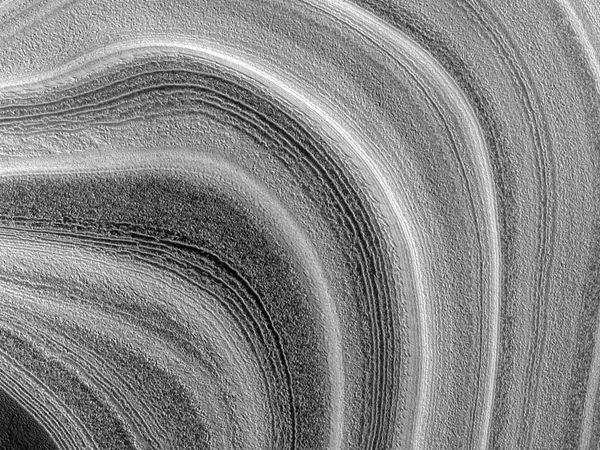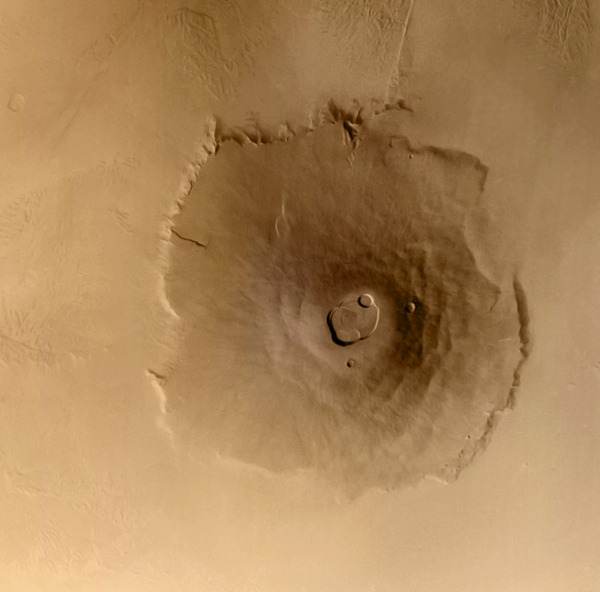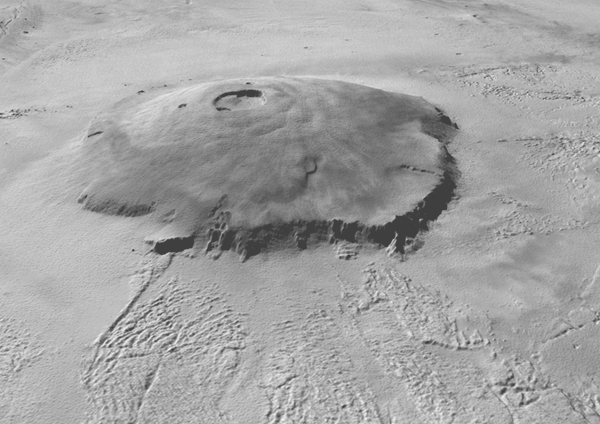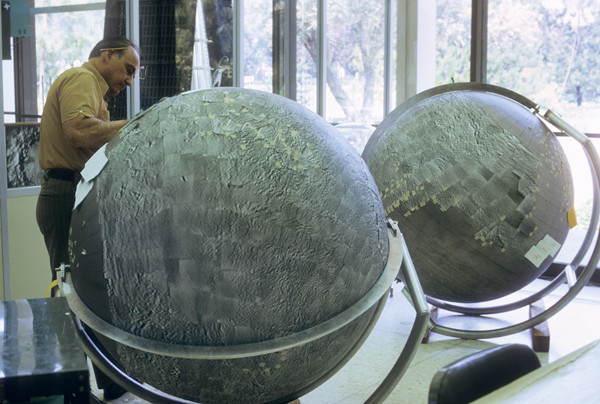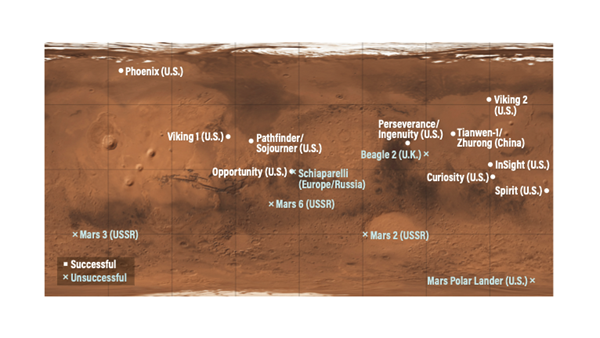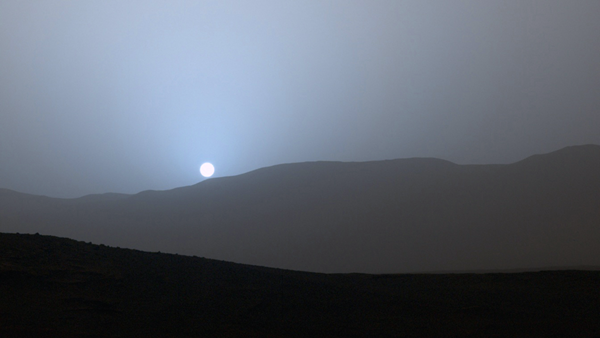Fifty years ago this November, three spacecraft were bearing down on Mars in a frantic race to become the first mission to orbit it.
They were the survivors of a fleet of five. Of that group, two were NASA efforts: Mariner 8 and Mariner 9, jointly known as the Mariner Mars 71 Project. The other three were Soviet: M71-S (S for “Sputnik”), Mars 2, and Mars 3.
All five spacecraft were designed to orbit the Red Planet, and Mars 2 and Mars 3 were also designed to deploy landers that would attempt the first robotic surface explorations of that world. After having lost the race to put a man on the Moon two years earlier, the Soviets were determined to beat the U.S. to the surface of Mars, even if only with robotic missions.
But when the dust settled, there was one standout performer: Mariner 9. That spacecraft is remembered among the most successful interplanetary missions of all time. Its systematic mapping of the martian surface in all its grandeur not only paved the way for future generations of robotic explorers, it forever changed our understanding of our neighboring planet.
Before probes visited Mars, the world had seemed Earth-like in so many ways. Then, when earlier Mariner missions made flybys of the Red Planet in the 1960s, their limited images triggered something of a disappointment: a barren world covered in craters like the Moon, albeit with a thin atmosphere. But Mariner 9 showed Mars to be a world unto itself.
Meeting Mars
The five missions that launched toward Mars in May 1971 set a record for a single year that remains unbeaten to this day.
The campaigns of both the U.S. and USSR got off to an inauspicious start. Mariner 8 was the first to launch, on May 9. But the mission quickly ended in disaster as the Atlas rocket’s Centaur upper stage tumbled out of control just five minutes after launch, dooming the spacecraft to a watery grave north of Puerto Rico.
Just two days later, the M71-S mission also met an early end. After a Proton rocket put the spacecraft into a parking orbit around Earth, the upper stage booster engine failed to fire and the spacecraft fell back to Earth two days later.
The ambitions of both nations were salvaged by their insurance policy of launching multiple spacecraft to the same target — a policy that has largely been abandoned in recent decades due to budget constraints. The launches of Mars 2 and Mars 3 on May 19 and 28, respectively, were successful, as was the launch of Mariner 9 on May 30. The race was on to become the first spacecraft to orbit the Red Planet.
Even though it was the last to lift off, the vagaries of interplanetary trajectories meant that Mariner 9 had the potential to reach Mars orbit first (although M71-S could have beaten Mariner 9 if its launch had succeeded). Indeed, on the evening of Nov. 13 EST, after a 167-day flight, a 15-minute burn of Mariner 9’s main engine allowed Mars to capture the spacecraft into orbit.
The Mars 3 lander performed better, but space historians continue to debate its ultimate fate even today. The USSR claims that it achieved the first soft landing on the martian surface. But communications with the lander were lost around 20 seconds after landing, and no useful data were downlinked to Earth. Even if it did land safely, it was a pyrrhic victory.
Still, by the end of 1971, humanity had three functional orbiters around Mars. Scientists around the world were eager to build upon the initial glimpses of that world provided by the earlier Mariner 4, 6, and 7 flyby missions. But Mars had other plans.
Into the maelstrom
One reason for the flurry of martian launch attempts in 1971 is because Earth passed extremely close to Mars during that year’s opposition — just 0.38 astronomical unit (AU), where 1 AU is the average distance between Earth and the Sun. This allowed for the shortest possible travel times between the two planets.
That favorable August opposition also meant that professional and amateur astronomers back on Earth were getting outstanding views of the 20″- to 25″-wide Red Planet as the three orbiters approached it throughout the summer and early fall. What they saw in late September was stunning: Mars was rapidly being engulfed in one of its famous and unpredictable global dust storms. Within three weeks, the entire planet was totally obscured.
Despite being so close to the planet, all three orbiters had to wait for the dust to clear to view the martian surface. Mars 2 was in an 18-hour elliptical orbit but had been programmed to take most of its data during close approaches. Mars 3 had even less-frequent opportunities for up-close observations: During orbital insertion, its engine had shut down early, leaving it in a highly elliptical orbit lasting nearly 13 days.
Nevertheless, during their three-month primary operations periods, both missions managed to return significant amounts of data about the planet’s temperature, gravity, and magnetic fields — plus a total of 60 dust-obscured images. However, hardly anyone now remembers their contributions to Mars science.
Star performer
On the other hand, Mariner 9 enjoyed spectacular success, thanks to its longevity — enabling it to wait out the storm — and adaptability. Following Mariner 8’s demise, Mariner 9’s mission profile was reprogrammed so that it could accomplish almost all the objectives originally planned for both spacecraft. And while the spacecraft bided its time, Mariner 9 mission scientists used an impressive collection of then-cutting-edge ultraviolet and infrared spectrometers to learn as much as possible about the dust storm itself.
In the pre-Mariner era, the importance of the planet’s largest dust storms had been overlooked. Earthbound astronomers had often observed local and regional obscurations known as yellow clouds, but thought that global events were extremely rare. In 1956, one such dust storm encircled the planet; as the first in the Kodachrome film era of modern color photography, it made a significant impression on the professional and amateur planetary astronomy community. But Mariner 9 visited just as the greatest dust storm on record was raging. It was the first truly global storm observed — even the polar caps were briefly hidden from view for a time.
One of the mission’s more puzzling discoveries was that the planet’s surface temperature was significantly lower when the atmosphere was dustier. Among those who pored over these measurements were Mariner 9 team members Carl Sagan and his first graduate student Jim Pollack, an expert in planetary atmospheres. They and others would combine Mariner 9 data with surface data gathered a few years later by the Viking landers — as well as data on Earth’s surface temperatures after large volcanic eruptions — to develop models that explained how dust suspended in a planet’s atmosphere cool the surface while simultaneously warming the upper atmosphere.
Sagan and his colleagues eventually used these models to predict that a global nuclear war between the superpowers on Earth would result in a nuclear winter — a massive cooling of our planet’s surface. Clearly, understanding our neighboring planets like Mars can prove to be more than just academic.
Mars emerges
The dust finally began to clear from the martian atmosphere in early 1972, allowing Mariner 9 to begin systematically mapping the entire surface of Mars. Planetary scientist and space artist William K. Hartmann, then a young member of the Mariner 9 science team, recalled how shortly after the spacecraft arrived, everything was completely obscured by dust except for the four mysterious dark spots near the equator:
“One day, Carl Sagan came running down to the science team room from the upstairs ‘computer’ room that had been receiving images from the Goldstone tracking antenna, waving a Polaroid photo of the TV screen (the mode of initial transfer of Mariner 9 images to the science team!). The photo revealed a pretty clear volcanic caldera in a summit protruding from the clouds. That was the day that everyone realized the dark spots were enormous shield volcanoes.”
Shield volcanoes are common geologic features on Earth; among the most famous are the Hawaiian volcanoes Mauna Kea and Mauna Loa. The volcanic structures discovered on Mars, however, make even Earth’s largest examples seem puny by comparison. The largest martian volcano, comparable in area to the state of Arizona but towering some 82,000 feet (25 kilometers) above the nearby plains, was named Olympus Mons because it coincided with the perennially cloudy region that 19th century Mars observer Giovanni Schiaparelli had dubbed Nix Olympica, the Snows of Olympus. The three other dusky spots corresponded to the shield volcanoes now known as Ascraeus Mons, Pavonis Mons, and Arsia Mons, from north to south.
Among the most surprising of Mariner 9’s many discoveries — especially after the discouraging results from earlier Mariner flybys that showed a barren Moon-like landscape — was a variety of dry river valleys on Mars. Some of these are now referred to as outflow channels and appear to emerge from jumbled areas of chaotic terrain. Their closest Earth analogues are deep channels like those found in the Channeled Scablands in eastern Washington state, which were formed by cataclysmic floods during the last glacial maximum some 20,000 years ago. Other dry river valleys resemble typical slower-forming river-carved valleys and distributary valley networks on Earth.
Most were found in the southern highlands of Mars, which contains ancient, heavily cratered terrain. This suggested that sometime in the distant past, liquid water flowed on the planet’s surface. Since the surface of Mars — with its freezing temperatures and low atmospheric pressure — cannot support liquid water today, there must have been a time in the ancient past when the planet was warmer and wetter. This period was perhaps 2 billion to 4 billion years ago, with the exact dates and duration still debated by scientists. In retrospect, we can say that Mariner 9 enabled the discovery of what is likely to be one of the most stark and impressive examples of climate change in the history of our solar system.
A new view of Mars
As Mars’ surface was mapped over the course of the mission, the Mariner 9 team visualized its progress by pasting individual spacecraft images onto a huge globe in Theodore von Kármán Auditorium at JPL. Ultimately, more than 7,000 images covering 85 percent of the planet were pasted to that globe.
As the mission continued, it became clear that the earlier Mariner flyby missions had simply been unlucky: Their close-range images had only shown the heavily cratered old plains of the southern hemisphere. Due to this unintended selection bias, they had missed many of Mars’ most intriguing features. Instead of returning these rather uninteresting lunarlike landscapes, Mariner 9 revealed a revolutionary new Mars with a rich geologic, atmospheric, climatic, and — potentially — even biologic history.
And, in a real tour de force, Mariner 9 photographed Mars’ two diminutive moons, Phobos and Deimos. Discovered only in 1877, they had appeared as mere starlike points in even the largest telescopes on Earth. Mariner 9 captured them at close range, revealing surfaces pocked with craters and, in the case of Phobos, the first hints of strange grooves. (These grooves would later be imaged at much higher resolution by the Viking orbiters, but their origins are still mysterious.)
With so many achievements, it is difficult to choose any one as the most enduring of Mariner 9’s legacies. But a case could be made for its reinvigoration of the nascent field of astrobiology. The buzz created by the discovery of the planet’s evolving surface and history of climate change dramatically restored Mars back from a moribund analogue of the Moon (with a thin atmosphere) to its position as a leading candidate for a potentially once habitable world in our solar system.
A lasting presence
That excitement helped planetary scientists and NASA to promote and create a pair of new missions: Viking 1 and 2. Each mission consisted of an orbiter and a lander. The orbiters mapped the surface and atmosphere in more detail, and the landers performed the first scientifically meaningful surface missions on Mars. They owed their success to Mariner 9 in a very real sense, as their landing sites were selected based on Mariner 9 mapping.
Mariner 9, and to a lesser extent Mars 2 and Mars 3, also initiated what has now become a long-term robotic presence at the Red Planet. After those pioneering missions completed their work in 1971 and 1972, the Viking orbiters continued close-up reconnaissance and exploration from 1976 to 1980. They and their landers compiled an impressive list of discoveries and achievements and generated new hypotheses of their own.
Mars orbit has now been continuously occupied for nearly 25 years — initially by follow-on NASA missions, but more recently by orbiters from the space agencies of Europe, India, the United Arab Emirates, and China. Currently, an incredible eight robotic orbital emissaries from Earth ply the Red Planet’s skies.
Many of these orbiters and their predecessors also served as scouts and communications relay satellites for a similarly impressive battalion of landers, rovers, and even an aircraft. A total of 13 spacecraft have done meaningful science on the surface of the Red Planet, six of which are still active today: the Insight and Tianwen-1 landers, the Curiosity, Perseverance, and Zhurong rovers, and the Ingenuity helicopter drone. Mars is a busy place — it has become the most actively studied world in our solar system behind only Earth itself and our close companion, the Moon.
We don’t know exactly where Mariner 9 is today. After exhausting the fuel for its attitude control thrusters, NASA turned off the spacecraft on Oct. 27, 1972. At the time, orbital dynamics engineers predicted that Mariner 9 would remain in orbit for perhaps another 50 years or more, after which time it would burn up in the martian atmosphere.
Perhaps sometime soon, then, one of our robotic avatars from the Blue Planet will witness a spectacular new shooting star blazing across the Red Planet’s dusty sky — the final fireworks from Mariner 9, among the most productive and impactful deep-space missions ever flown.

